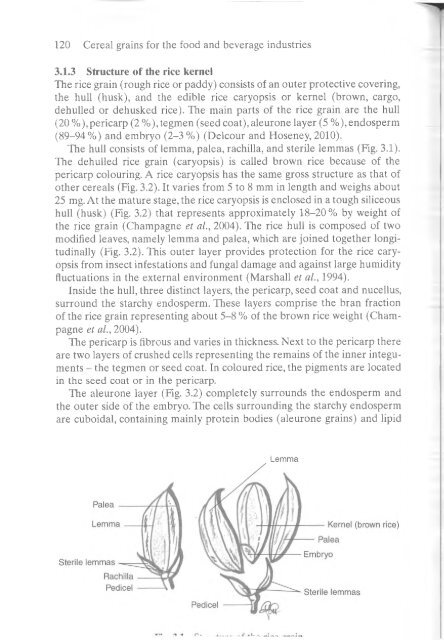Arendt und Zannini - 2013 - Cereal grains for the food and beverage industries
Arendt und Zannini - 2013 - Cereal grains for the food and beverage industries
Arendt und Zannini - 2013 - Cereal grains for the food and beverage industries
You also want an ePaper? Increase the reach of your titles
YUMPU automatically turns print PDFs into web optimized ePapers that Google loves.
120 <strong>Cereal</strong> <strong>grains</strong> <strong>for</strong> <strong>the</strong> <strong>food</strong> <strong>and</strong> <strong>beverage</strong> <strong>industries</strong><br />
3.1.3 Structure of <strong>the</strong> rice kernel<br />
The rice grain (rough rice or paddy) consists of an outer protective covering,<br />
<strong>the</strong> hull (husk), <strong>and</strong> <strong>the</strong> edible rice caryopsis or kernel (brown, cargo,<br />
dehulled or dehusked rice). The main parts of <strong>the</strong> rice grain are <strong>the</strong> hull<br />
(20 %), pericarp (2 %), tegmen (seed coat), aleurone layer (5 %), endosperm<br />
(89-94%) <strong>and</strong> embryo (2-3%) (Delcour <strong>and</strong> Hoseney, 2010).<br />
The hull consists of lemma, palea, rachilla, <strong>and</strong> sterile lemmas (Fig. 3.1).<br />
The dehulled rice grain (caryopsis) is called brown rice because of <strong>the</strong><br />
pericarp colouring. A rice caryopsis has <strong>the</strong> same gross structure as that of<br />
o<strong>the</strong>r cereals (Fig. 3.2). It varies from 5 to 8 mm in length <strong>and</strong> weighs about<br />
25 mg. At <strong>the</strong> mature stage, <strong>the</strong> rice caryopsis is enclosed in a tough siliceous<br />
hull (husk) (Fig. 3.2) that represents approximately 18-20 % by weight of<br />
<strong>the</strong> rice grain (Champagne et ai, 2004). The rice hull is composed of two<br />
modified leaves, namely lemma <strong>and</strong> palea, which are joined toge<strong>the</strong>r longitudinally<br />
(Fig. 3.2). This outer layer provides protection <strong>for</strong> <strong>the</strong> rice caryopsis<br />
from insect infestations <strong>and</strong> fungal damage <strong>and</strong> against large humidity<br />
fluctuations in <strong>the</strong> external environment (Marshall et ai, 1994).<br />
Inside <strong>the</strong> hull, three distinct layers, <strong>the</strong> pericarp, seed coat <strong>and</strong> nucellus,<br />
surro<strong>und</strong> <strong>the</strong> starchy endosperm. These layers comprise <strong>the</strong> bran fraction<br />
of <strong>the</strong> rice grain representing about 5-8 % of <strong>the</strong> brown rice weight (Champagne<br />
et ai, 2004).<br />
The pericarp is fibrous <strong>and</strong> varies in thickness. Next to <strong>the</strong> pericarp <strong>the</strong>re<br />
are two layers of crushed cells representing <strong>the</strong> remains of <strong>the</strong> inner integuments<br />
- <strong>the</strong> tegmen or seed coat. In coloured rice, <strong>the</strong> pigments are located<br />
in <strong>the</strong> seed coat or in <strong>the</strong> pericarp.<br />
The aleurone layer (Fig. 3.2) completely surro<strong>und</strong>s <strong>the</strong> endosperm <strong>and</strong><br />
<strong>the</strong> outer side of <strong>the</strong> embryo. The cells surro<strong>und</strong>ing <strong>the</strong> starchy endosperm<br />
are cuboidal, containing mainly protein bodies (aleurone <strong>grains</strong>) <strong>and</strong> lipid<br />
Lemma

















